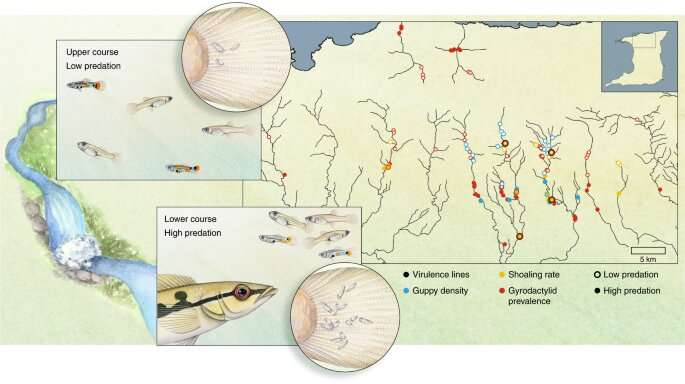Group living means safety from predators but nastier diseases for guppies

Birds of a feather flock together, but when guppies gather, they get really bad worms.
New University of Pittsburgh research shows that fish that group together to avoid being eaten run the risk of breeding nastier parasites—a pattern that’s likely common across the animal kingdom and may even be the case for some human diseases.
“There are so many animal hosts that shoal or flock or herd for defense against predation,” said lead author Jason Walsman, a postdoctoral biology researcher in the Kenneth P. Dietrich School of Arts and Sciences. “Predators driving hosts into the arms of increasingly deadly parasites should happen a lot—it’s probably happening in hundreds or thousands of species every day.”
The species Walsman studies is guppies on the island of Trinidad, an unlikely star of decades of evolution research. In some areas, these guppies are eaten by all manner of bigger fish, so they bunch together for safety; others live a relatively stress-free life in upstream utopias, protected by impassable waterfalls from the hungry predators downstream. These differences make them the perfect study species for understanding how predators steer the path of their prey’s evolution.
Using data from past experiments, Walsman created a simplified mathematical model to describe how guppies and their flatworm parasites evolve. Then the team, including Assistant Professor of Biological Sciences Jessica Stephenson, conducted experiments using wormy guppies collected in Trinidad. They found the same results their model predicted: In more social groups of fish, their parasites had evolved to be more deadly.
The team published their results last month in the journal Nature Ecology and Evolution.
“The biggest surprise was how well it worked: We told the model to predict the virulence that would evolve in these populations, and it gets it right to within 10%,” said Walsman. “If you’re used to physics, that might not sound super accurate, but for ecology that’s crazy accurate.”
The team’s model expands on the idea that although parasites often damage their hosts, their real evolutionary goal is to simply make more of themselves. But when multiple parasites compete for the same host, it becomes an arms race where whoever reproduces faster wins, and the host becomes collateral damage.
For guppies, that threat comes in the form of a unique flatworm parasite that lives on their skin: Gyrodactylus, sometimes referred to as the Russian nesting doll parasite. “They’re super charismatic. It’s so cool,” said Stephenson. “When a mother worm gives birth to the daughter worm, she’ll just sort of burst out of mum and latch onto the fish next to her. And then the mum can grow a penis and start inseminating other worms.”
And that weird nickname? It’s because the daughters are born already pregnant, allowing them to multiply alarmingly quickly, explained Walsman. “It’s just worms on worms on worms.”
The more social the group of guppies, the more likely it is that they’ll exchange strains of worms, breeding varieties that are a bigger threat, the team confirmed. Their results showed that these superworms may even be more dangerous to guppies than hungry predators.
Ironically for a study about social distancing, the COVID-19 pandemic almost put a stop to the project. Several lab members were in Trinidad collecting fish in March 2020, and only on a second try were they able to get a shipment of wormy fish back to Pittsburgh for laboratory experiments. Traveling back home, too, meant navigating airport crowds leaving the country. “It was so stressful, but they all got back safely, so it felt like a huge win,” said Stephenson.
As social animals, humans may be host to some of the same evolutionary processes the team describe, but only in the case of some diseases. Influenza is one example that appears to meet the right criteria: multiple variants can coexist inside the same person, and more harmful variants spread between people more effectively.
But beyond humans, the study provides a new perspective for scientists who seek to understand how whole ecosystems function. The social lives of animals all over the world—and thus where they live and how they behave—are likely shaped by the twin threats of being eaten and getting sick.
“People talk about group living as this really important anti-predator defense, and it has all of these benefits associated with it,” Stephenson said. “But when parasites become super virulent, then perhaps they become even more problematic than this sort of rare chance of being eaten. This study suggests that animals’ sociality should really be dictated by the balance of these forces.”
What guppy guts can teach us about evolution
Jason C. Walsman et al, Shoaling guppies evade predation but have deadlier parasites, Nature Ecology & Evolution (2022). DOI: 10.1038/s41559-022-01772-5
Citation:
Group living means safety from predators but nastier diseases for guppies (2022, June 15)
retrieved 15 June 2022
from https://phys.org/news/2022-06-group-safety-predators-nastier-diseases.html
This document is subject to copyright. Apart from any fair dealing for the purpose of private study or research, no
part may be reproduced without the written permission. The content is provided for information purposes only.
For all the latest Science News Click Here
For the latest news and updates, follow us on Google News.

